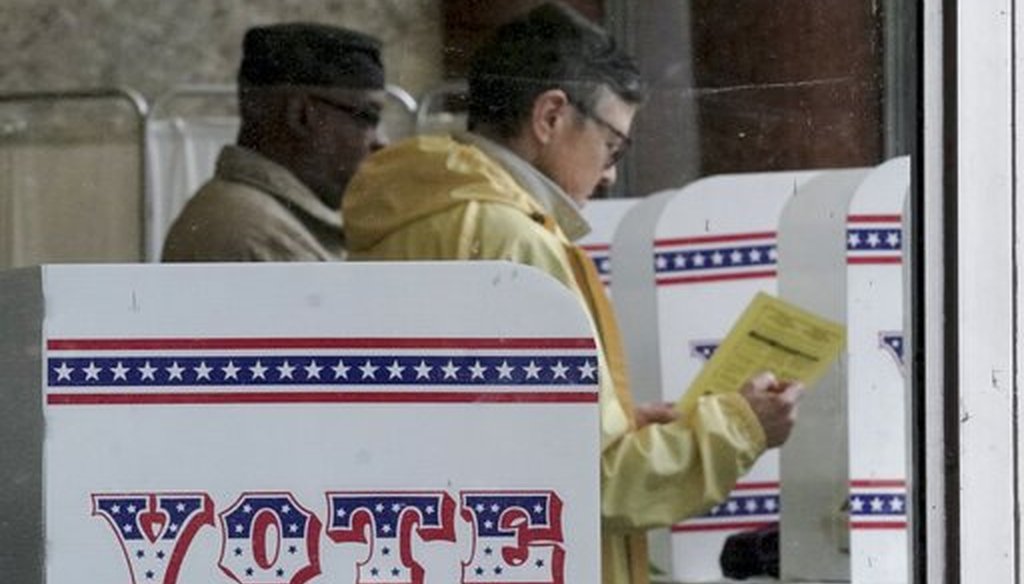

Our only agenda is to publish the truth so you can be an informed participant in democracy.
We need your help.


Early voters cast early ballots in Milwaukee on March 18, 2020. Wisconsin has not postponed its April 7 presidential primary despite coronoavirus concerns. (AP)
Wisconsin Election Commission data shows that since 2000, turnout in partisan elections — that is, the fall cycle — has ranged from 44% to 73% of adults.
In nonpartisan elections, which occur in spring, turnout has ranged from nearly 12% to 34%.
Just a few months after a tumultuous November election, Wisconsin voters will be heading to the polls this spring with the balance of power on the state Supreme Court at stake.
The retirement of Justice Patience Drake Roggensack, who served on the court since 2003, has created an opening. Roggensack is part of the four-justice conservative majority on the seven-member court.
As such, if a liberal candidate wins, it would shift the 4-3 balance in the opposite direction.
There are four candidates running in the Feb. 21 primary and the top two finishers on the ballot will move on to the April 4 election. Justices serve 10-year terms.
The court is officially nonpartisan, but campaigns and supporters backing the candidates are decidedly partisan: Former Supreme Court Justice Daniel Kelly and Waukesha County Circuit Judge Jennifer Dorow, are both on the conservative side, and Dane Circuit County Judge Everett Mitchell and Milwaukee County Circuit Judge Janet Protasiewicz, both on the liberal side.
"This (Wisconsin Supreme Court) is a very important election for the state of Wisconsin, and historically, our spring elections have a smaller turnout associated with them," state Senate Minority Leader Melissa Agard, D-Madison, said Jan. 3 on PBS Wisconsin’s "Here & Now."
"We do know that because of the split government that we have in Wisconsin and the history of laws being litigated up to the Supreme Court in Wisconsin over the last decade or more that the Supreme Court's makeup really does matter and does affect the everyday lives of the people of the state of Wisconsin."
As the spring election gets fired up, we thought Agard’s statement would be a good chance to dig into how spring turnout compares with the fall elections.
Let’s take a look.
The Wisconsin Elections Commission calculates voter turnout as a percentage of the voting-age population -- people age 18 and older — as estimated by the Demographic Services Center of the Wisconsin Department of Administration.
That’s because of the state’s same-day registration, which means any eligible voter can register at the polls and does not have to be on a set list before Election Day.
The data shows that since 2000, turnout in partisan general elections has ranged from nearly 44% to more than 73% of adults. The lowest partisan general election turnout figure, which the commission’s webpage documents back to 1948, is 39% in 1974.
In nonpartisan elections since 2000, spring cycle turnout has ranged from nearly 12% to 34%.
According to the commission’s webpage, which looks at nonpartisan elections only since 2000, the lowest spring turnout was 11.8% in 2006, in which state Supreme Court Justice N. Patrick Crooks ran unopposed.
Additional examples of low turnout nonpartisan races include (asterisks * denote incumbents):
2000 Supreme Court, *Diane S. Sykes vs. Louis B. Butler, 20.92%, with Sykes the winner.
2007 Supreme Court, Linda Clifford vs. Annette Ziegler, 19.36%, with Ziegler the winner.
2008 Supreme Court, *Louis Butler vs. Michael Gableman, 19.34%, with Gableman the winner. (Butler lost to Sykes in 2000, was appointed to the Supreme Court in 2004, and was defeated in re-election bid by Gableman in 2008.)
2011 Supreme Court, *David Prosser vs. JoAnne Kloppenburg, 34.31%, with Prosser the winner.
2013 State superintendent, *Tony Evers vs. Don Pridemore, 20.45%, with Evers the winner.
2021 State superintendent, Jill Underly vs. Deborah Kerr, 20.84%, with Underly the winner.
Agard said, "Historically, our spring elections (including for state Supreme Court) have a smaller turnout associated with them."
According to the Elections Commission, since 2000 turnout percentages for spring elections range from just shy of 12% for a 2006 state Supreme Court race to 34% for the contentious state Supreme Court race between Kloppenburg and Prosser.
Even that 34% is well below the fall general election turnout for 2012, which came in at about 70%.
For a statement that is accurate and there’s nothing significant missing, our rating is True.
Wisconsin PBS "Here & Now," Jan. 3, 2023
Wisconsin Court System "Supreme Court"
Milwaukee Journal Sentinel "Wisconsin Supreme Court candidates weigh in on redistricting in first joint election appearance," Dec. 5, 2022.
Milwaukee Journal Sentinel "Milwaukee County judge announces candidacy for Wisconsin Supreme Court, decries 'radical right-wing extremists'," May 26, 2022
Milwaukee Journal Sentinel "Former Wisconsin Supreme Court Justice Daniel Kelly announces 2023 run to rejoin the court," Sept. 8, 2022
Email, John D. Johnson, Marquette University, Jan. 6, 2023
Wisconsin Elections Commission, "Statistics and Data"
State of Wisconsin Department of Administration Demographic Services Center
PolitiFact Truth-O-Meter ratings
In a world of wild talk and fake news, help us stand up for the facts.
